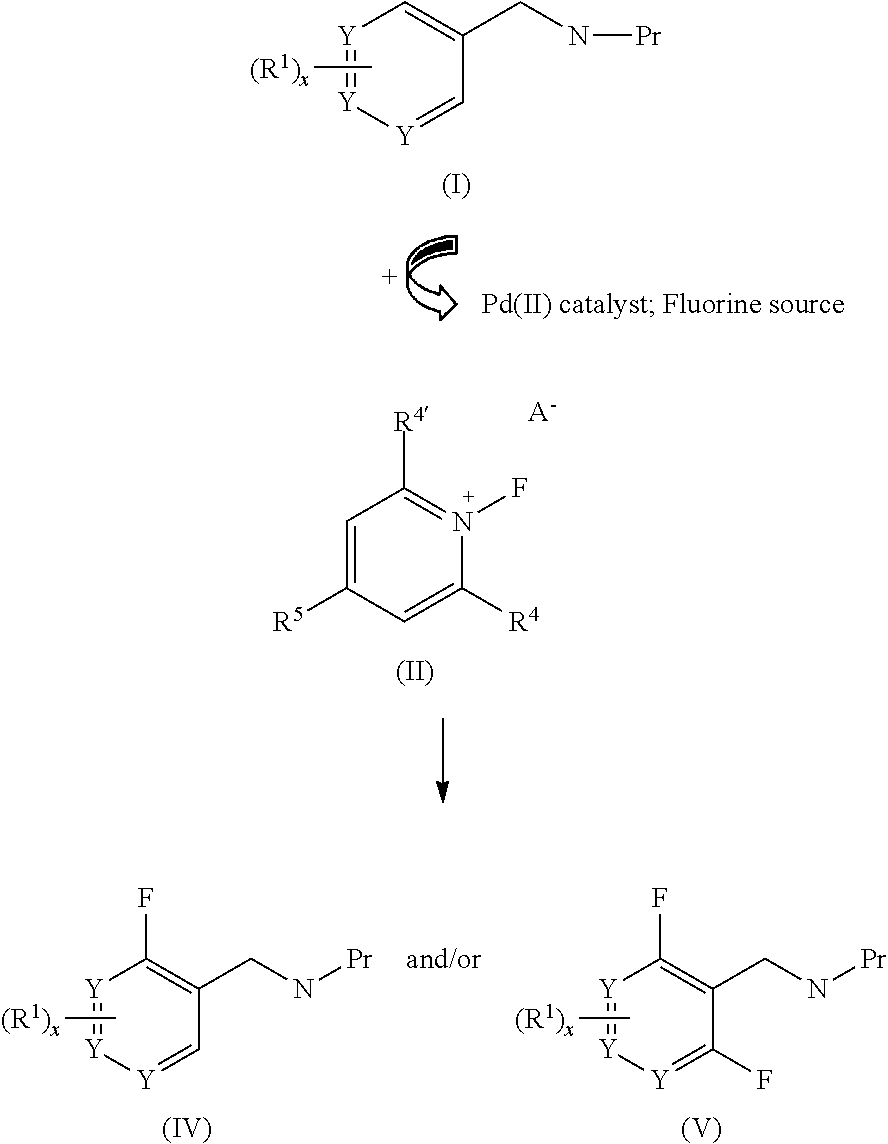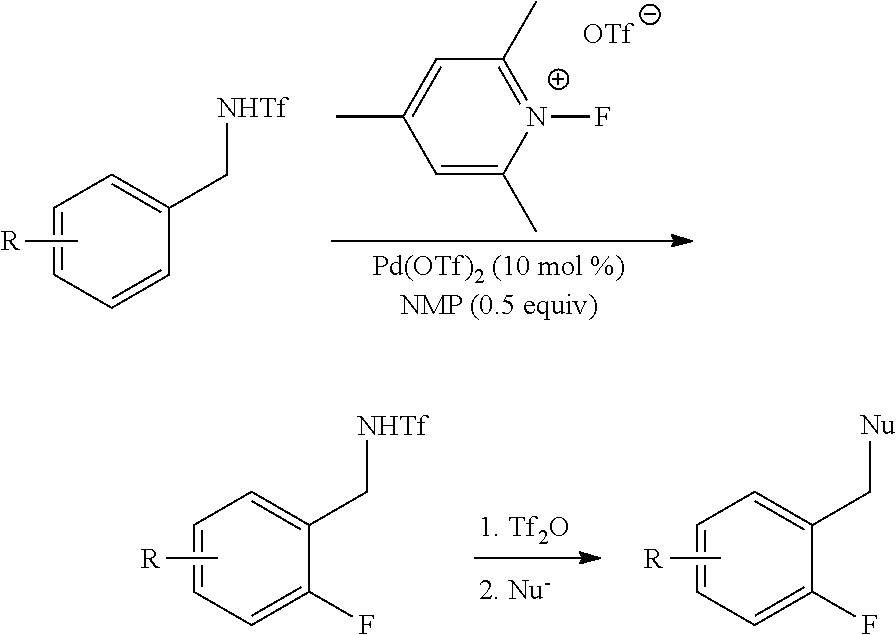Palladium-catalyzed ortho-fluorination
a technology of orthofluorination and palladium, which is applied in the field of palladiumcatalyzed orthofluorination, can solve the problems of reductive elimination of fluoride from pd(ii) species and significant task of developing new methods for the introduction of fluorines into arenes
- Summary
- Abstract
- Description
- Claims
- Application Information
AI Technical Summary
Benefits of technology
Problems solved by technology
Method used
Image
Examples
example 1
Synthesis of Trifluoromethanesulfonamides 1a-o and 2a
[0186]
[0187]General Procedure: To a stirred solution of benzylamine (50 mmol, 1.0 equiv.) in dichloromethane (100 mL) was added triethylamine (7.0 mL, 50 mmol, 1.0 equiv.) at −78° C. under nitrogen. After stirring for 5 min at −78° C., trifluoromethanesulfonic anhydride (8.8 mL, 52.5 mmol, 1.05 equiv.) was added dropwise and the mixture was stirred for 1 h at that temperature before being quenched by water (100 mL). The organic layer was separated and the aqueous layer was extracted with dichloromethane (50 mL×2). The combined organic phase was washed with brine (100 mL), and then dried over Na2SO4. Evaporation and column chromatography on silica gel (ethyl acetate / hexane=1:100-1:5 as eluant) afforded corresponding trifluoromethanesulfonamides 1a-o and 2a as colorless or pale yellow oil or solid, giving a >90% yield in all cases.
[0188]1H NMR (400 MHz, CDCl3) δ 7.30-7.21 (m, 4H), 4.82 (br, 1H), 4.46 (d, J=5.6 Hz, 2H), 2.38 (s, 3H);...
example 2
General Procedure of Pd(OTf)2-Catalyzed Ortho-Fluorination
[0204]In a 20 mL sealed tube, benzylamine triflamides 1 (0.2 mmol, 1.0 equiv.), Pd(OTf)22H2O (8.8 mg, 0.02 mmol, 0.1 equiv.), N-fluoro-2,4,6-trimethylpyridinium triflate 10 (1.5 equiv. for 1b-1h and 2a, 2.0 equiv. for 1i-1l and la for mono-fluorination, 3.0 equiv. for 1a and 1m-1h for di-fluorination), NMP (10 μL, 0.1 mmol, 0.5 equiv.) [or DMF (0.5 equiv.) for 1a and 1l for mono-fluorination)] were dissolved in 0.5 mL dry DCE (or PhCF3 for 1a and 1m-1h for di-fluorination) under air. The tube was sealed with a Teflon lined cap and the reaction mixture was stirred at 120° C. for the given time in Tables 1-2. After cooling to room temperature, the mixture was concentrated under vacuum and the residue was purified by column chromatography on silica gel with a gradient eluant of hexane and ethyl acetate afforded the product 2.
[0205]1H NMR (400 MHz, CDCl3) δ 7.39-7.31 (m, 1H), 6.99-6.93 (m, 2H), 5.27 (br, 1H), 4.58 (d, J=5.6 Hz, 2...
example 3
Transformations of Triflamides
[0220]Synthesis of 16:
[0221]To a stirred solution of 2a (514.4 mg, 2.0 mmol, 1.0 equiv.) in acetone (10 mL) was added K2CO3 (414.7 mg, 3.0 mmol, 1.5 equiv.) and then MeI (373.5 μL, 6.0 mmol, 3.0 equiv.) dropwise at room temperature (r.t.). The reaction mixture was heated to reflux and stirred for 8 h. After cooling to r.t., acetone was removed under vacuum and water (10 mL) was added to the residue, extracted with diethyl ether (15 mL×3), dried over Na2SO4 and concentrated under vacuum. Purification of the residue by column chromatography on silica gel (hexane-ethyl acetate=50 / 1 as eluant) afforded 16 (500 mg, 92% yield) as colorless oil. 1H NMR (400 MHz, CDCl3) δ 7.43 (dt, J=7.6, 1.6 Hz, 1H), 7.39-7.33 (m, 1H), 7.21 (dt, J=7.6, 1.2 Hz, 1H), 7.13-7.08 (m, 1H), 4.57 (br, 2H), 2.96 (s, 3H); 13C NMR (100 MHz, CDCl3) δ 161.0 (d, JC-F=246.0 Hz), 130.6, 130.5 (d, JC-F=5.0 Hz), 124.8 (d, JC-F=3.6 Hz), 121.2 (d, JC-F=14.0 Hz), 120.2 (q, JC-F=321.6 Hz), 115.7 (d...
PUM
 Login to View More
Login to View More Abstract
Description
Claims
Application Information
 Login to View More
Login to View More - R&D
- Intellectual Property
- Life Sciences
- Materials
- Tech Scout
- Unparalleled Data Quality
- Higher Quality Content
- 60% Fewer Hallucinations
Browse by: Latest US Patents, China's latest patents, Technical Efficacy Thesaurus, Application Domain, Technology Topic, Popular Technical Reports.
© 2025 PatSnap. All rights reserved.Legal|Privacy policy|Modern Slavery Act Transparency Statement|Sitemap|About US| Contact US: help@patsnap.com



